Related Research Articles

Acoustics is a branch of physics that deals with the study of mechanical waves in gases, liquids, and solids including topics such as vibration, sound, ultrasound and infrasound. A scientist who works in the field of acoustics is an acoustician while someone working in the field of acoustics technology may be called an acoustical engineer. The application of acoustics is present in almost all aspects of modern society with the most obvious being the audio and noise control industries.

In speech science and phonetics, a formant is the broad spectral maximum that results from an acoustic resonance of the human vocal tract. In acoustics, a formant is usually defined as a broad peak, or local maximum, in the spectrum. For harmonic sounds, with this definition, the formant frequency is sometimes taken as that of the harmonic partial that is most augmented by a resonance. The difference between these two definitions resides in whether "formants" characterise the production mechanisms of a sound or the produced sound itself. In practice, the frequency of a spectral peak differs from the associated resonance frequency, except when, by luck, harmonics are aligned with the resonance frequency.
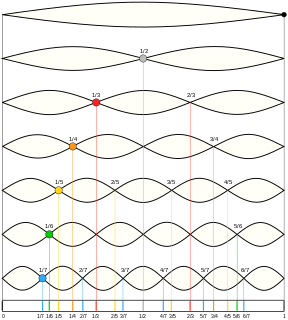
A harmonic is any member of the harmonic series. The term is employed in various disciplines, including music, physics, acoustics, electronic power transmission, radio technology, and other fields. It is typically applied to repeating signals, such as sinusoidal waves. A harmonic of such a wave is a wave with a frequency that is a positive integer multiple of the frequency of the original wave, known as the fundamental frequency. The original wave is also called the 1st harmonic, the following harmonics are known as higher harmonics. As all harmonics are periodic at the fundamental frequency, the sum of harmonics is also periodic at that frequency. For example, if the fundamental frequency is 50 Hz, a common AC power supply frequency, the frequencies of the first three higher harmonics are 100 Hz, 150 Hz, 200 Hz and any addition of waves with these frequencies is periodic at 50 Hz.
An nth characteristic mode, for n > 1, will have nodes that are not vibrating. For example, the 3rd characteristic mode will have nodes at L and L, where L is the length of the string. In fact, each nth characteristic mode, for n not a multiple of 3, will not have nodes at these points. These other characteristic modes will be vibrating at the positions L and L. If the player gently touches one of these positions, then these other characteristic modes will be suppressed. The tonal harmonics from these other characteristic modes will then also be suppressed. Consequently, the tonal harmonics from the nth characteristic modes, where n is a multiple of 3, will be made relatively more prominent.
Absolute pitch (AP), often called perfect pitch, is a rare ability of a person to identify or re-create a given musical note without the benefit of a reference tone. AP may be demonstrated using linguistic labeling, associating mental imagery with the note, or sensorimotor responses. For example, an AP possessor can accurately reproduce a heard tone on a musical instrument without "hunting" for the correct pitch.

In music, timbre, also known as tone color or tone quality, is the perceived sound quality of a musical note, sound or tone. Timbre distinguishes different types of sound production, such as choir voices and musical instruments. It also enables listeners to distinguish different instruments in the same category.
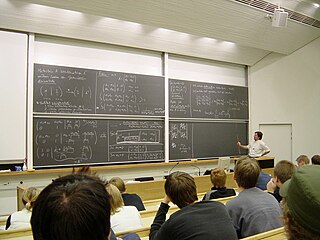
A blackboard is a reusable writing surface on which text or drawings are made with sticks of calcium sulfate or calcium carbonate, known, when used for this purpose, as chalk. Blackboards were originally made of smooth, thin sheets of black or dark grey slate stone.
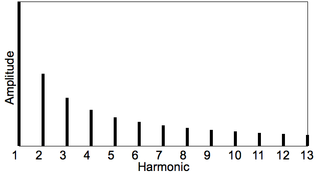
In music, inharmonicity is the degree to which the frequencies of overtones depart from whole multiples of the fundamental frequency.

A harmonic sound is said to have a missing fundamental, suppressed fundamental, or phantom fundamental when its overtones suggest a fundamental frequency but the sound lacks a component at the fundamental frequency itself. The brain perceives the pitch of a tone not only by its fundamental frequency, but also by the periodicity implied by the relationship between the higher harmonics; we may perceive the same pitch even if the fundamental frequency is missing from a tone.
The octave illusion is an auditory illusion discovered by Diana Deutsch in 1973. It is produced when two tones that are an octave apart are repeatedly played in alternation ("high-low-high-low") through stereo headphones. The same sequence is played to both ears simultaneously; however when the right ear receives the high tone, the left ear receives the low tone, and conversely. Instead of hearing two alternating pitches, most subjects instead hear a single tone that alternates between ears while at the same time its pitch alternates between high and low.

In acoustics, loudness is the subjective perception of sound pressure. More formally, it is defined as, "That attribute of auditory sensation in terms of which sounds can be ordered on a scale extending from quiet to loud." The relation of physical attributes of sound to perceived loudness consists of physical, physiological and psychological components. The study of apparent loudness is included in the topic of psychoacoustics and employs methods of psychophysics.
Sound localization is a listener's ability to identify the location or origin of a detected sound in direction and distance.

An equal-loudness contour is a measure of sound pressure level, over the frequency spectrum, for which a listener perceives a constant loudness when presented with pure steady tones. The unit of measurement for loudness levels is the phon and is arrived at by reference to equal-loudness contours. By definition, two sine waves of differing frequencies are said to have equal-loudness level measured in phons if they are perceived as equally loud by the average young person without significant hearing impairment.

Volley theory states that groups of neurons of the auditory system respond to a sound by firing action potentials slightly out of phase with one another so that when combined, a greater frequency of sound can be encoded and sent to the brain to be analyzed. The theory was proposed by Ernest Wever and Charles Bray in 1930 as a supplement to the frequency theory of hearing. It was later discovered that this only occurs in response to sounds that are about 500 Hz to 5000 Hz.

Hearing range describes the range of frequencies that can be heard by humans or other animals, though it can also refer to the range of levels. The human range is commonly given as 20 to 20,000 Hz, although there is considerable variation between individuals, especially at high frequencies, and a gradual loss of sensitivity to higher frequencies with age is considered normal. Sensitivity also varies with frequency, as shown by equal-loudness contours. Routine investigation for hearing loss usually involves an audiogram which shows threshold levels relative to a normal.
Computational auditory scene analysis (CASA) is the study of auditory scene analysis by computational means. In essence, CASA systems are "machine listening" systems that aim to separate mixtures of sound sources in the same way that human listeners do. CASA differs from the field of blind signal separation in that it is based on the mechanisms of the human auditory system, and thus uses no more than two microphone recordings of an acoustic environment. It is related to the cocktail party problem.
Dichotic Pitch is a pitch heard due to binaural processing, when the brain combines two noises presented simultaneously to the ears. In other words, it cannot be heard when the sound stimulus is presented monaurally but, when it is presented binaurally a sensation of a pitch can be heard. The binaural stimulus is presented to both ears through headphones simultaneously, and is the same in several respects except for a narrow frequency band that is manipulated. The most common variation is the Huggins Pitch, which presents white-noise that only differ in the interaural phase relation over a narrow range of frequencies. For humans, this phenomenon is restricted to fundamental frequencies lower than 330 Hz and extremely low sound pressure levels. Experts investigate the effects of the dichotic pitch on the brain. For instance, there are studies that suggested it evokes activation at the lateral end of Heschl's gyrus.
Scraping a chalkboard with the fingernails produces a sound and feeling which most people find extremely irritating. The basis of the innate reaction to the sound has been studied in the field of psychoacoustics.
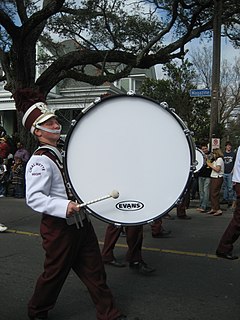
In physics, sound is a vibration that propagates as an acoustic wave, through a transmission medium such as a gas, liquid or solid.
Psychoacoustics is the branch of psychophysics involving the scientific study of sound perception and audiology—how humans perceive various sounds. More specifically, it is the branch of science studying the psychological responses associated with sound. Psychoacoustics is an interdisciplinary field of many areas, including psychology, acoustics, electronic engineering, physics, biology, physiology, and computer science.
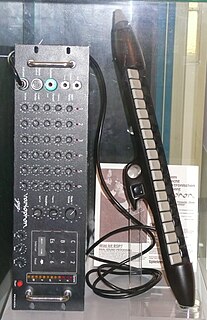
A Variophon is an electronic wind instrument invented in 1975 by researchers at the University of Cologne. It synthesizes sounds using the principle of most common brass instruments, creating sounds based on the vibration of the player's lips and breath and the resonance in a particular body. For this purpose, the instrument is played using a pipe-controller, while the pitch is controlled either by keys on the pipe itself or in later models, an external keyboard. The Variophon can alternate in timbres, imitating a variety of wind instruments, ranging from the harmonica to clarinet, saxophone or tuba. The variophon has a processing unit, dubbed "the music cockpit" which the controller must be connected to. The controlling voltages of the blow controller and keys combine to influence the shape, width, and height of the electric pulses. The pulses it creates are modeled by the pulse formations of real wind instrument sounds, which is how the variophon replicates the sounds of these instruments.
References
- ↑ Reuter, Christoph; Michael Oehler (2011). "Psychoacoustics of chalkboard squeaking". The Journal of the Acoustical Society of America. 130 (2545): 2545. doi:10.1121/1.3655174.
- ↑ "Acoustical Society of America - 161st Lay Language Papers". Acoustics.org. 2011-11-03. Archived from the original on 2011-11-04. Retrieved 2013-10-02.CS1 maint: discouraged parameter (link)